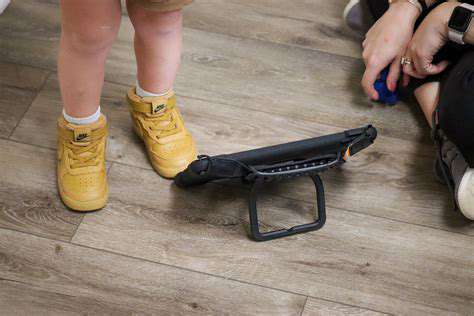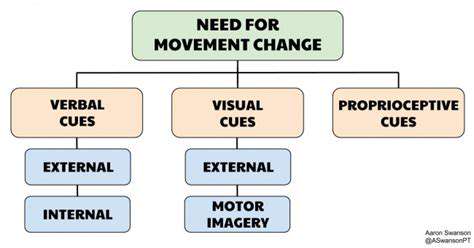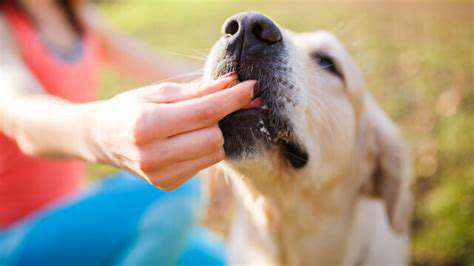Incorporating Basic Commands into Your Puppy's Daily Routine
The sit command provides the perfect starting point for obedience training. Begin with your dog in a calm state, holding a treat near their nose, then slowly move it upward and backward over their head. As their nose follows the treat, their bottom will naturally lower. The moment their rear touches the ground, say sit clearly and give the reward. This precise timing - marking the exact moment of correct behavior - helps create clear mental connections.
Once your dog understands the verbal command, introduce a hand signal (like an open palm moving upward) to reinforce the cue visually. Practice in multiple locations to help your dog generalize the command beyond just the training area. Start with very short sessions (just a few minutes) to keep the experience positive and end before your dog loses focus.
Mastering the Stay Command
After solidifying the sit, introduce stay by having your dog sit, then holding your palm out like a stop sign while saying stay. Take one small step back, then immediately return and reward if they held position. The key is progressing in tiny increments - first duration (how long), then distance (how far you move away), and finally distraction level. If your dog breaks the stay, simply reset without scolding and try again with an easier version.
Build duration in seconds, not minutes. Start with just 2-3 seconds of successful stays before rewarding. When practicing with distance, initially just shift your weight or lean slightly away before attempting full steps. This gradual approach prevents frustration and sets your dog up for success at each difficulty level.
Understanding Come
The recall command could one day save your dog's life, so invest proper time in making it reliable. Begin in a small, enclosed area with minimal distractions. Get excited, use an enthusiastic tone, and say come! while backing away to encourage movement toward you. When they arrive, lavish praise and offer high-value rewards like small pieces of chicken or cheese. Never use the come command for anything negative (like ending playtime or giving medication) - you want your dog to associate it exclusively with positive outcomes.
Practice with a long leash (15-30 feet) in safe outdoor areas before attempting off-leash recalls. If your dog doesn't respond, avoid repeating the command - instead, gently reel them in with the leash while staying positive, then try again with more enticing rewards or fewer distractions. This preserves the command's integrity.
Reinforcing Good Behavior
Effective reinforcement requires immediacy and variety. The reward must come within 1-2 seconds of the desired behavior to create a clear connection. Rotate between food treats, verbal praise (Yes! Good dog!), physical affection, and short play sessions to maintain your dog's interest. Watch for your dog's personal preferences - some work harder for food, while others value toys or praise more highly.
Keep training sessions short but frequent. Several 5-minute sessions spread through the day work better than one long session where attention wanders. End each session on a success, even if you need to make the final exercise slightly easier to ensure a positive finish.
Troubleshooting Common Issues
When hitting training roadblocks, first assess basic needs. Is your dog tired, hungry, or needing a bathroom break? Sometimes what appears as stubbornness is simply physical discomfort. For distraction problems, increase distance from the distraction rather than expecting focus right beside it. If a particular command isn't clicking, try breaking it down into smaller steps or changing your reward system.
For persistent issues, consider filming a training session to review later. You might spot timing issues with rewards or unintentional body language cues. If problems continue after adjusting your approach, consult a certified professional trainer who uses positive reinforcement methods. They can provide customized solutions for your specific situation.
Essential Commands: Start Simple, Stay Consistent
Understanding the Command Structure
Effective command training follows a logical progression. Begin with one-word cues in quiet environments before adding complexity. Each command should have a distinct verbal cue and consistent hand signal. This clear structure helps dogs understand exactly what's being asked of them. Mastering these fundamentals creates a framework for adding more advanced skills later.
Document your training progress in a notebook or app. Note which commands your dog responds to best, which need more work, and what reward types are most effective. This record helps you spot patterns and maintain consistency across training sessions, especially if multiple family members participate in training.
Using Keywords for Precision
Choose command words carefully and use them consistently. Avoid similar-sounding words for different commands (sit vs. stay work well, while down and no sound too similar). Use a cheerful, upbeat tone for commands you want your dog to enjoy following (like come), and a firmer tone for important safety commands (like leave it).
Once you've chosen a command word, stick with it. Changing from down to lie down mid-training only confuses your dog. If you accidentally use the wrong word, ignore the mistake and give the correct command rather than repeating the incorrect version.
Employing Modifiers and Arguments
After your dog masters basic commands, you can add modifiers to increase difficulty. For stay, you might add duration (stay for 30 seconds), distance (stay while I walk across the room), or distraction (stay while I toss a toy). Introduce one new variable at a time, and temporarily lower other difficulty aspects when adding something new.
For example, when first adding duration to stay, stand right next to your dog. When adding distance, ask for very short durations. This systematic approach prevents overwhelming your dog and makes each new challenge achievable.
Navigating the Command Line Interface
Think of command training like programming - you're creating reliable behavioral responses to specific cues. Start with simple programs (basic commands) before attempting complex code (advanced behaviors). Just as programmers test small code segments before combining them, train individual command components separately before chaining them together.
Troubleshooting Common Errors
If your dog consistently struggles with a command, analyze possible causes. Are you using inconsistent cues? Is the reward insufficiently motivating? Is the environment too distracting? Break the problem down systematically rather than repeating failed attempts.
Common issues often stem from unclear communication. Film yourself giving commands to check for inconsistent body language or timing. Sometimes what we think we're doing differs from what we actually do. This objective review can reveal simple fixes for stubborn problems.
Consistency and Practice for Mastery
Regular, short practice sessions trump occasional long ones. Aim for 5-minute sessions 3-4 times daily rather than one weekly hour-long session. This frequency helps cement learning while preventing fatigue. Practice commands in various locations to help your dog generalize the behavior beyond just the training area.
Incorporate commands into daily life. Ask for a sit before meals, a stay before opening doors, or a come when it's time for walks. This integration reinforces that commands apply everywhere, not just during formal training sessions. The more naturally commands fit into your routine, the more reliable they'll become.
Integrating Commands into Daily Routines

Command Integration Strategies
Seamlessly blending training into daily life strengthens command reliability. Instead of setting aside separate training time, look for natural opportunities throughout your day. Before meals, have your dog sit and wait calmly as you prepare their food. At doors, practice stay before going outside. During walks, incorporate occasional recalls or heel practice.
Create clear transition cues to help your dog understand when commands are expected. For example, putting on a specific treat pouch or using a particular leash might signal training mode. These consistent signals help your dog mentally prepare to focus and follow directions.
Prioritization and Scheduling
Focus on mastering a few key commands before introducing new ones. Safety commands like recall and leave-it deserve priority over tricks or advanced obedience. Schedule training when your dog is naturally alert but not overexcited - after some exercise but before they're tired.
Align command practice with your dog's natural rhythms. Practice focus commands when they're naturally attentive, and settle commands when they're winding down. This harmony between training and natural behavior makes learning feel more intuitive.
Contextual Awareness
Dogs don't automatically generalize commands to all environments. Practice each command in multiple locations - your home, yard, quiet parks, and eventually busier areas. Start with minimal distractions and gradually increase difficulty as your dog succeeds. If they struggle in a new environment, temporarily make the exercise easier (closer distance, higher-value rewards) to rebuild confidence.
Notice environmental factors that affect your dog's responsiveness. Wind can carry scents that distract, while hard surfaces might make some dogs hesitant to lie down. Adapt your expectations based on these variables rather than insisting on perfect performance in challenging conditions.
Training and Feedback
Regularly assess your dog's progress with each command. Can they perform it reliably at home? In new locations? With distractions present? This ongoing evaluation helps you identify which skills need more reinforcement. Keep notes on what works and what doesn't to refine your approach.
Pay attention to your dog's feedback too. If they're struggling with a command they previously knew, check for physical issues (soreness, hearing problems) or emotional factors (stress, fear). Training should remain a positive experience - if your dog shows signs of stress, dial back the difficulty.
Automation and Efficiency
As commands become second nature, you can begin combining them into routines. A morning ritual might involve sit for putting on the leash, stay at the door, then heel during the walk. These practiced sequences help your dog anticipate what's expected in familiar situations.
Create default behaviors - actions your dog offers automatically in certain situations. For example, sitting whenever you stop on a walk, or lying down when you're preparing their meal. These ingrained behaviors minimize the need for constant commands and create polite habits.
Consistency and Patience: The Cornerstones of Success
Understanding the Importance of Consistency
Training success hinges on unwavering consistency. All family members should use the same commands, gestures, and rules. If one person allows jumping while another discourages it, the dog receives mixed messages. Establish clear household standards and ensure everyone enforces them uniformly.
Consistency extends beyond just commands. Maintain regular schedules for feeding, walks, and training sessions. Predictable routines help dogs feel secure and make them more receptive to learning. When dogs know what to expect, they can focus better on what's being asked of them.
Patience: Embracing the Journey
Every dog learns at their own pace. Some master commands quickly, while others need more repetition. Resist comparing your dog to others - focus on their individual progress. Celebrate small improvements rather than fixating on how far you have to go. If you feel frustrated, end the session positively and try again later with a fresh perspective.
Understand that regression is normal. Dogs might forget commands during adolescence or when stressed. Rather than seeing this as failure, view it as an opportunity to strengthen the foundation. Return to basics temporarily and rebuild gradually.
Setting Realistic Goals
Break training objectives into achievable steps. Instead of aiming for perfect obedience, set smaller goals like sit reliably at meals or come when called in the backyard. These milestones provide regular feelings of accomplishment that maintain motivation for both you and your dog.
Adjust expectations based on your dog's age, breed, and personality. A high-energy working breed might learn quickly but need more mental stimulation, while a more laid-back companion dog might progress slower but have excellent focus. Work with your dog's natural tendencies rather than against them.
The Role of Practice in Mastering Commands
Skills deteriorate without regular reinforcement. Even after your dog masters a command, continue occasional practice to maintain reliability. Think of it like muscle memory - the more ingrained the behavior becomes, the more automatic it will be when truly needed.
Vary your practice approach to keep it engaging. Sometimes use high-value rewards, other times just praise. Practice in different locations and at different times of day. This variability strengthens the command's reliability across contexts.
Identifying and Addressing Challenges
When facing persistent training challenges, analyze all variables. Is the command unclear? Are rewards insufficient? Are expectations unrealistic for the dog's age or experience level? Often, the solution involves simplifying the exercise rather than repeating failed attempts.
For specific issues like distraction problems, create controlled training scenarios. If your dog struggles with recall around other dogs, initially practice at distances where they can still focus, then gradually decrease the distance as they improve. This systematic approach builds confidence.
Leveraging Resources for Support
Don't hesitate to seek professional guidance when needed. A few sessions with a certified trainer can provide customized solutions for stubborn issues. Join local training classes or online communities to exchange tips with other dog owners facing similar challenges.
Continually educate yourself about dog behavior and training methods. Understanding canine psychology helps you interpret your dog's actions and tailor your approach more effectively. The more you learn, the better you can communicate with your canine companion.
Review and Reflection for Continuous Improvement
Periodically evaluate your training program's effectiveness. Which commands are rock-solid? Which need work? Are there new behaviors you'd like to add? This ongoing assessment ensures your training remains relevant to your dog's current needs and your lifestyle.
Reflect on your own growth as a trainer. Notice how your timing, consistency, and ability to read your dog have improved. Training is a journey for both handler and dog - celebrate progress on both ends of the leash. This mindful approach fosters a deepening bond and more enjoyable training experiences.











